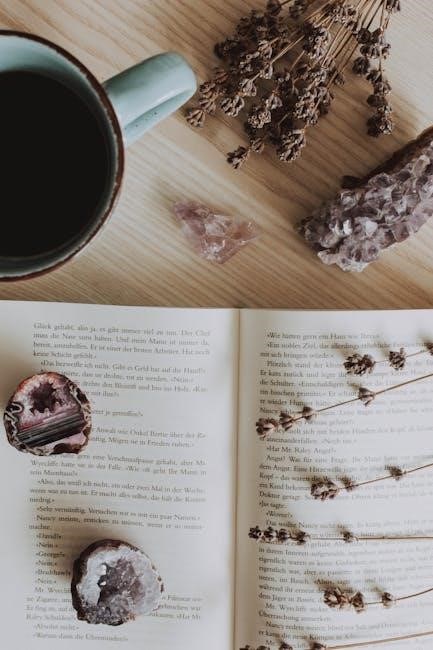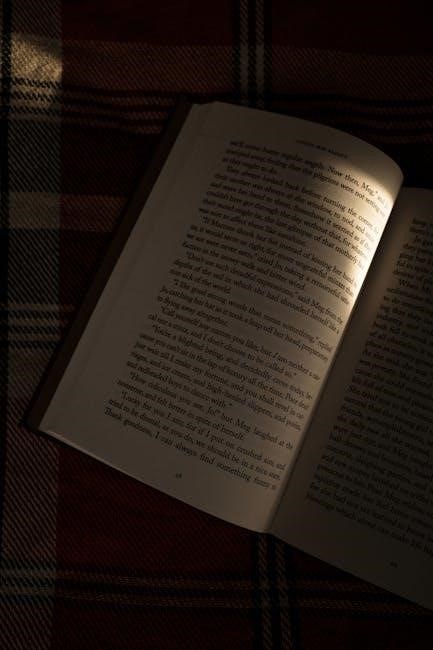The Story of O is a provocative novel exploring themes of power dynamics, submission, and eroticism through the journey of a young woman named O. This controversial tale, written by Anne Desclos under the pseudonym Pauline Réage, delves into O’s willing submission and transformation, sparking debates on identity, desire, and control. Its explicit content and psychological depth have made it a landmark in erotic literature, despite its scandalous reception upon publication in 1954.
Overview of the Novel
The Story of O is a controversial and deeply provocative novel that follows the journey of its protagonist, a young woman known only as O. The story revolves around her voluntary submission to various forms of sexual and psychological experiences, exploring themes of power, control, and identity. O, a beautiful fashion photographer, is initiated into a world of erotic submission by her lover, René, who takes her to the enigmatic Château Roissy. There, she undergoes a series of physical and emotional transformations, blurring the lines between pain and pleasure. The novel’s explicit content, coupled with its exploration of BDSM and power dynamics, has made it a landmark in erotic literature, sparking both admiration and criticism for its unflinching portrayal of desire and submission.
Historical Context and Publication
The Story of O was first published in French in 1954 under the title Histoire d’O, written by Anne Desclos under the pseudonym Pauline Réage. The novel’s explicit content and exploration of BDSM themes caused immediate controversy, leading to its censorship in several countries. Despite the scandal, it gained significant attention and acclaim, becoming a literary phenomenon. The true identity of the author remained a mystery until 1994, when Dominique Aury, a respected literary figure, revealed herself as the writer. This revelation added to the novel’s intrigue, solidifying its place as a groundbreaking work in erotic literature and sparking ongoing debates about its themes and implications.

Background of the Author
Anne Desclos, writing under the pseudonym Pauline Réage, was a French author and translator. Her true identity as the writer of The Story of O remained hidden until 1994, shocking the literary world and cementing her legacy as a bold and enigmatic figure in erotic literature.
Anne Desclos and Her Pseudonyms
Anne Desclos, a French author and translator, adopted the pseudonym Pauline Réage to publish The Story of O in 1954. This name, derived from French, signifies her anonymity and reflects the novel’s provocative nature. Desclos chose this pseudonym to separate her literary reputation from the controversial content of her work, ensuring her privacy while exploring themes of eroticism and submission. The use of a pen name allowed her to navigate the societal norms of her time, protecting her identity until its revelation in 1994, which shocked the literary community and solidified her place in erotic literature history.
Her Role in the Literary World
Anne Desclos, known for her bold literary contributions, held a dual identity as a respected translator and editor in the French publishing world. Her work at Éditions Gallimard showcased her intellectual prowess, while her pseudonymous novel, The Story of O, revealed her daring creative side. This duality underscored her influence in both mainstream and controversial literature. Desclos’ novel challenged societal norms, sparking debates on feminism, eroticism, and power dynamics, thus leaving a lasting impact on literary discourse and feminist theory. Her ability to navigate these contrasting roles solidified her legacy as a groundbreaking author who fearlessly explored taboo themes, reshaping the boundaries of erotic literature and intellectual dialogue.

Plot Summary
The Story of O follows the journey of a young woman, O, who is taken by her lover, René, to Château Roissy, where she submits to intense physical and psychological transformations, exploring themes of submission, control, and identity through her experiences.
The Journey of the Protagonist, O
O, a young and beautiful Parisian fashion photographer, embarks on a voluntary journey of submission and transformation. She is taken by her lover, René, to the enigmatic Château Roissy, where she is subjected to various forms of physical and psychological conditioning. O’s journey is marked by her gradual acceptance of her role as a submissive, exploring themes of power dynamics, identity, and self-discovery. Her experiences at the château challenge her perceptions of love, control, and liberation, leading to profound internal changes. The narrative delves into O’s emotional and physical struggles, as well as her ultimate embrace of her newfound identity, raising questions about the boundaries of desire and autonomy.
Key Events and Transformations
O’s journey begins with her introduction to the secretive Château Roissy, where she is initiated into a world of submission and discipline. A pivotal moment occurs when she is branded with a mark of ownership, symbolizing her complete surrender. Her relationship with René evolves as he pushes her further into this lifestyle, challenging her boundaries. O also encounters other figures, such as Sir Stephen, who play significant roles in her transformation. Throughout the novel, O’s identity shifts from independence to submission, questioning the limits of her desires and autonomy. These events provoke a deep exploration of power, control, and self-discovery, reshaping her understanding of love and submission.

Major Themes
The Story of O explores themes of power dynamics, submission, eroticism, and identity, delving into psychological transformations and the complexities of desire and control.
Power Dynamics and Submission
The Story of O intricately examines power dynamics through O’s voluntary submission to her lovers, exploring themes of control and surrender. Her journey portrays a complex interplay between dominance and compliance, where O’s identity evolves through her acceptance of powerlessness. The novel delves into psychological transformations, illustrating how submission becomes a form of liberation for O. This dynamic raises questions about autonomy and desire, challenging traditional notions of power and freedom. The explicit portrayal of these relationships highlights the tension between empowerment and subjugation, making it a central and controversial theme of the novel.
Eroticism and BDSM Elements
The Story of O is renowned for its explicit eroticism and detailed exploration of BDSM themes, presenting a world where sensuality and power intertwine. The novel vividly portrays O’s descent into a submissive lifestyle, emphasizing the psychological and physical aspects of her experiences. Erotic scenes are central to the narrative, serving not only to arouse but also to explore deeper themes of control and transformation. The blending of intense sensuality with psychological complexity has made the book a landmark in erotic literature, sparking both admiration and controversy for its unflinching portrayal of desire and submission.
Identity and Self-Discovery
The Story of O delves deeply into themes of identity and self-discovery, as the protagonist, O, navigates her complex journey of submission and transformation. Through her experiences, O grapples with her sense of self, exploring the boundaries of her desires and the depths of her psyche. The novel portrays her willingness to surrender as a form of self-discovery, where she learns to embrace her true nature amidst the challenges of her chosen path. This introspective exploration raises questions about autonomy, personal identity, and the interplay between freedom and submission, making O’s journey a profound and thought-provoking examination of self.

Character Analysis
O is the central character, a young woman who embodies submission and transformation. Her journey explores her willingness to surrender to desire and control, revealing psychological depth. René and other figures shape her path, highlighting power dynamics and emotional complexities that define her identity and relationships.
O: The Central Character
O, the protagonist, is a young and beautiful Parisian fashion photographer who willingly embraces a life of submission and transformation. Her journey begins with her lover, René, who introduces her to a world of eroticism and control. O’s character is defined by her acceptance of her role as a submissive, undergoing physical and psychological changes that reflect her deep desire to surrender. Her identity evolves as she navigates the complexities of her relationships and the demands placed upon her. Through her experiences, O’s character reveals a multifaceted exploration of power, desire, and self-discovery, making her one of literature’s most intriguing and controversial female figures.
René and Other Key Figures
René, O’s lover, plays a pivotal role in her journey, introducing her to a world of submission and control. He is the catalyst for her transformation, guiding her into the secretive and erotic realm of Château Roissy. René’s character embodies dominance and authority, shaping O’s experiences and desires. Other key figures include Sir Stephen, a mysterious and powerful figure who becomes deeply intertwined in O’s life, and various men who exert control over her. These characters represent different facets of power and desire, influencing O’s psychological and emotional evolution. Their roles highlight the interplay of control and submission, central to the novel’s exploration of human dynamics and eroticism.
Setting
The story unfolds primarily in two contrasting environments: the opulent Château Roissy, where O undergoes her transformative submission, and the vibrant city of Paris, reflecting her dual existence.
The Château Roissy and Its Significance
The Château Roissy serves as the central location where O’s transformation begins. This grand, isolated estate symbolizes a world of power and control, where societal norms are stripped away. It is here that O is subjected to various forms of sexual and psychological submission, reshaping her identity. The château’s opulent yet oppressive atmosphere underscores the themes of dominance and surrender, making it a pivotal setting in exploring the novel’s core themes of power dynamics and self-discovery. Its significance lies in its role as both a physical and metaphorical space for O’s journey into submission and liberation.
Parisian Context and Atmosphere
Set against the backdrop of 1950s Paris, the novel begins in the city’s elegant yet mysterious atmosphere. Paris serves as the initial setting where O’s journey into submission starts, blending seamlessly with the city’s romantic yet secretive vibe. The Parisian context introduces O’s dual life—a fashion photographer immersed in the city’s sophistication and a woman surrendering to her desires. This duality reflects the tension between public identity and private surrender, setting the stage for her eventual transformation at Château Roissy. The city’s allure and anonymity provide the perfect catalyst for O’s exploration of power, control, and self-discovery, mirroring the enigmatic nature of Paris itself.

Symbolism and Motifs
The novel employs symbolism through clothing and physical markings, representing power dynamics and transformation. These motifs underscore themes of identity and control, enriching the narrative’s depth and complexity.
The Use of Clothing and Accessories
Clothing and accessories in The Story of O serve as powerful symbols of submission and control. O’s attire, often minimal or restrictive, reflects her diminishing autonomy. Masks, collars, and high heels are used to emphasize her objectification and transformation. These elements not only signify her role as a submissive but also reinforce the themes of power dynamics and identity loss. Clothing becomes a tool for both physical and psychological domination, stripping O of her individuality and reducing her to a vessel for others’ desires. This motif underscores the novel’s exploration of eroticism and control.
Physical Markings and Their Meanings
Physical markings in The Story of O are deeply symbolic, representing O’s submission and transformation. Her body is branded with a marking from a hot iron, signifying ownership and permanent submission. The collar she wears is a visible symbol of her enslavement, while whip marks and chains emphasize her role as an object of desire. These physical alterations serve as reminders of her surrender to power dynamics. Each marking embodies her psychological and emotional transformation, reinforcing themes of control, identity loss, and the blurring of pain and pleasure. The marks on her body are both a manifestation of her submission and a testament to her journey of self-discovery.

Psychological Aspects
The Story of O explores O’s psychological journey, delving into her submission, identity, and the interplay between control and liberation. Her mental transformation is central to the narrative.
O’s Psychological Journey
O’s psychological journey in The Story of O is a complex exploration of submission, identity, and self-discovery. From her initial willingness to surrender to the demands of those around her, O navigates a path of profound mental and emotional transformation. Her submission is not merely physical but deeply psychological, as she grapples with the loss of autonomy and the blurring of boundaries between pleasure and pain. The novel delves into her internal struggles, revealing a resilience that allows her to endure physical and psychological challenges while maintaining a sense of self. Ultimately, O’s journey raises questions about liberation, control, and the true nature of desire, making her one of literature’s most compelling and enigmatic characters.
Themes of Control and Liberation
The Story of O intricately explores themes of control and liberation, presenting submission as a paradoxical path to freedom. O’s journey reveals how relinquishing control becomes a form of empowerment, as she embraces her desires and identity. The novel examines the interplay between dominance and surrender, suggesting that liberation can emerge from the willingness to let go. Through O’s experiences, the book challenges traditional notions of freedom, offering a provocative perspective on power dynamics and personal autonomy. This theme remains central to the novel’s exploration of human desire and the complexities of liberation through submission.

Reception and Controversy
The Story of O sparked significant controversy due to its explicit content, leading to bans in several countries. Despite the scandal, it remains a classic in erotic literature.
Initial Reception and Scandal
The publication of The Story of O in 1954 ignited immediate controversy due to its explicit erotic content and themes of submission and BDSM. The novel shocked readers and critics alike, leading to bans in several countries for its perceived obscenity. Despite the scandal, it gained notoriety and became a talking point in literary circles. The book’s anonymity, initially published under a pseudonym, further fueled speculation and intrigue. Its exploration of taboo subjects challenged societal norms, sparking debates about freedom of expression and artistic boundaries. The novel’s provocative nature solidified its reputation as a transgressive and controversial work, both praised and condemned upon its release.
Modern Perspectives on the Novel
In contemporary discussions, The Story of O is viewed through a lens of nuanced analysis, balancing its controversial themes with its literary merit. Modern critics often examine the novel as a exploration of power, consent, and identity, acknowledging its complexity beyond mere eroticism. Feminist discourse has evolved to interpret O’s journey as a symbol of self-discovery and autonomy, challenging earlier perceptions of victimhood. Additionally, the novel is celebrated for its influence on erotic literature and its role in breaking societal taboos. While debates about its implications remain, the book is now recognized for its cultural significance and enduring relevance in exploring human desire and empowerment.

Literary Style
The Story of O features a narrative technique that blends poetic language with explicit content, creating a balance between elegance and provocation. The novel’s style explores power dynamics through detailed descriptions of O’s experiences, maintaining a lyrical yet unflinching approach to its themes of submission and desire.
Narrative Technique and Language
The Story of O employs a first-person narrative, offering an intimate perspective on O’s experiences, blending poetic language with explicit descriptions. The text’s lyrical style contrasts with its unflinching portrayal of power dynamics, creating a unique tension. Sparse dialogue emphasizes O’s internal state, while detailed descriptions of settings and actions heighten the sensory impact. This technique immerses readers in O’s psychological journey, exploring themes of submission and control through a delicate balance of elegance and provocation. The language, both evocative and precise, underscores the novel’s exploration of desire, identity, and transformative submission.
Explicit Content and Its Purpose
The Story of O is renowned for its explicit content, which serves to explore themes of power, submission, and eroticism. Detailed sexual scenes illustrate the dynamics of control and surrender, while the unflinching portrayal of BDSM practices challenges societal norms. The explicit nature of the text is not gratuitous but purposeful, driving the narrative and revealing O’s psychological transformation. Through these depictions, the novel examines the interplay of pain, pleasure, and identity, provoking both fascination and controversy. The explicit content underscores the novel’s exploration of human desire and the boundaries of consent, making it a provocative yet thought-provoking work in erotic literature.
Cultural Impact
The Story of O has left an enduring mark on literature and culture, influencing erotic genres and sparking debates on sexuality and feminism. Its provocative themes continue to resonate, challenging societal norms and inspiring adaptations across media, ensuring its relevance in modern discourse on power, identity, and desire.
Influence on Erotic Literature
The Story of O has been a groundbreaking work in erotic literature, setting a new standard for explicit content and psychological depth. Its exploration of BDSM themes and power dynamics has inspired countless authors, reshaping the genre by blending sensuality with intellectual exploration. The novel’s frank portrayal of sexual submission and its impact on the protagonist’s identity have made it a benchmark, encouraging more open discussions about sexuality and desire. Its influence is evident in modern erotic fiction, where themes of control and liberation continue to be central, ensuring its lasting legacy in the literary world.
Impact on Feminist Discourse
The Story of O has sparked intense debate in feminist discourse, with some viewing it as a exploration of female empowerment through self-discovery and others criticizing its portrayal of submission. The novel challenges traditional notions of gender roles and sexuality, offering a complex lens through which to examine power dynamics. While some feminists argue that O’s voluntary submission undermines feminist ideals, others see it as a radical expression of sexual autonomy and liberation. The book’s exploration of female desire and identity continues to provoke discussions, making it a significant, albeit controversial, work in feminist literary analysis and cultural critique.

Adaptations and Legacy
The Story of O inspired the 1975 film The Story of O, directed by Just Jaeckin, which became a cult classic. Its legacy endures as a cultural touchstone, influencing discussions on BDSM and eroticism in literature and media.
Film and Other Media Adaptations
The 1975 film adaptation of The Story of O, directed by Just Jaeckin, became a cult classic, faithful to the novel’s themes of submission and eroticism. While controversial, it captured the essence of O’s journey, featuring Corinne Cléry as O. The film’s success led to sequels and inspired other works, including documentaries exploring the novel’s cultural impact. Despite challenges in translating the book’s explicit content to screen, the adaptation remains a significant interpretation of the story. Its influence extends beyond cinema, shaping discussions on BDSM and eroticism in media.
Legacy in Popular Culture
The Story of O has left an indelible mark on popular culture, inspiring countless references in music, art, and film. Its themes of power and submission have influenced fashion trends and sparked debates in media. The novel’s controversial nature has kept it relevant, with mentions in TV shows, podcasts, and social media. It continues to be a subject of fascination, symbolizing both liberation and control. Its impact endures, making it a cultural touchstone for discussions on desire and identity.
The Story of O remains a profound exploration of power, submission, and identity, leaving a lasting impact on literature and contemporary discussions.
Final Thoughts on the Novel’s Significance
The Story of O is a landmark work that challenges societal norms and explores complex themes of power, identity, and desire. Its controversial nature and explicit content have sparked debates, yet it remains a significant contribution to erotic literature. The novel’s ability to provoke thought on control and liberation ensures its relevance, offering readers a deep psychological journey. Despite its scandalous history, The Story of O continues to influence feminist discourse and popular culture, cementing its place as a thought-provoking and enduring literary work.
Enduring Relevance in Contemporary Discussions
The Story of O remains a pivotal work in modern conversations about sexuality, power, and identity; Its exploration of BDSM themes and consent continues to resonate, offering insights into the complexities of human desire. The novel’s frank portrayal of submission and control challenges readers to reflect on personal boundaries and societal expectations. Despite its controversial past, The Story of O is increasingly appreciated for its nuanced psychological depth and its role in shaping feminist and erotic literature. Its influence is evident in media, art, and culture, ensuring its relevance in contemporary discussions about freedom, empowerment, and the human condition.











